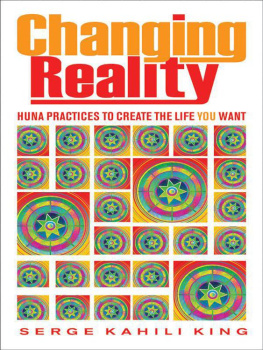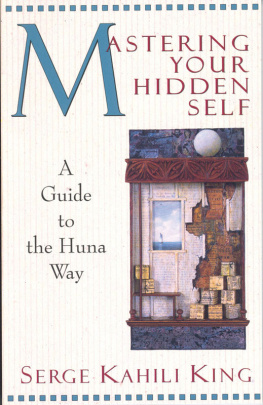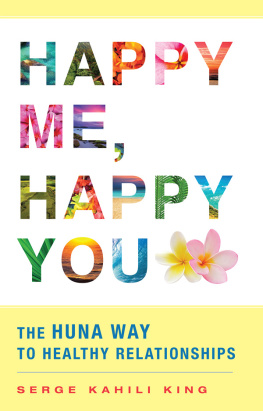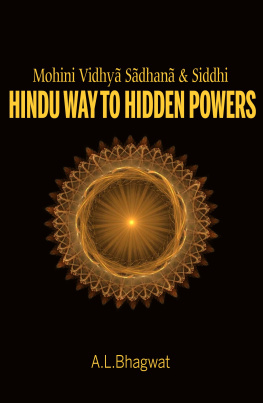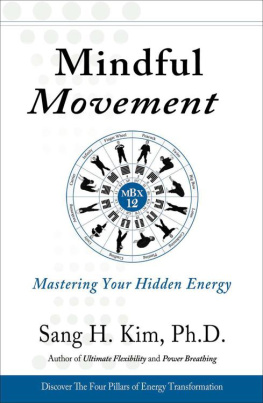This book is dedicated to Gloria Dawn Denkhaus
my best student, my best friend, and my wife.
Huna philosophy is about learning to become a conscious cocreator with the Universe. Hawaiian shaman King uses Kahuna healing methods to help us access the hidden energy of life, develop powers of concentration, and make friends with the deepest aspect of our being.
Learn how your Higher Self, or aumakua, is contacted in the dream dimension, get in touch with the Mana, the hidden energy of life. Develop higher powers of concentration by utilizing the tikis, created images of sight, sound, and feeling in meditation. Become aware of your subconscious, an integral part of your being, which impatiently awaits communion with the ego.

Serge Kahili King
Mastering your Hidden Self
A Guide to the Huna Way
ePub r1.0
Sharadore17.12.13
Original Title: Mastering your Hidden Self: A Guide to the Huna Way
Serge Kahili King, 1985
Cover Adaptation: Sharadore
Digital Editor: Sharadore
ePub base r1.0
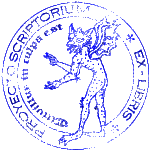
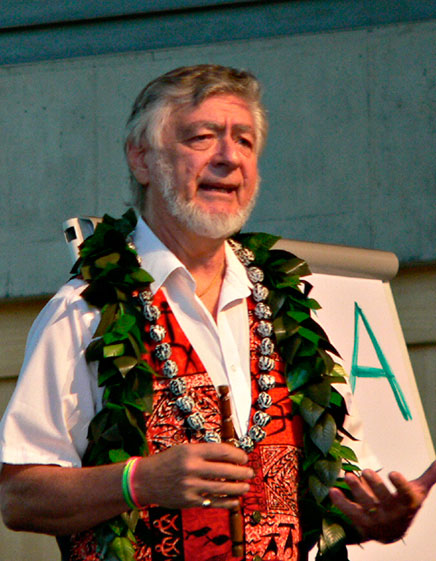
SERGE KAHILI KING, Ph.D. Author of many works on Huna and Hawaiian shamanism, including Urban Shaman and Instant Healing. He has a doctorate in psychology and was trained in shamanism by the Kahili family of Kauai as well as by African and Mongolian shamans. Dr. King is the Executive Director of Aloha International, a non-profit, worldwide network of individuals who have dedicated themselves to making the world a better place.
Notes
Acknowledgments
Acknowledgments are due to all my students whose feedback enabled me to keep refining this material; to Jane Roberts and Barry Kaufman, from whose books I borrowed certain phrases to explain the Huna knowledge; to my editor, Shirley Nicholson, whose good advice helped to stabilize the theme of the book; and finally to my typewriter, Fred whose persistent good will kept the manuscript flowing.
Preface
Since my last book, Kahuna Healing, many people have asked me about practical applications of Huna insight into the nature of the self, which is the reason for bringing out the present book. They have also asked me about my own training as a kahuna. Since this has a great deal of bearing on your use of this book, Id like to "talk story" a hit on that subject.
In my life so far Ive experienced many different forms of training, including school and college, postgraduate studies, the military, special language and technical courses, and others. In my opinion, kahuna training was the hardest of all. Perhaps I can explain that better by relating a few incidents of such training.
My father was my toughest teacher. Before I understood what kahuna training was all about. I harhored a lot of resentment toward him for certain things he did. One occasion that stands out in my memory took place when I was fifteen. We were building a house, working in the basement, and he told me to get him an awl. I had never heard of an awl so I asked him what it was. He simply said, "Just go get one." Well instead of applying anything I had learned the previous year about intuition and awareness, I got mad at how "unfair" he was. I blocked my mind to everything but my anger, and of course found nothing even resembling an awl After a few more wasted trips and mounting resentment on my part, he went and got the thing himsel.
You could say he should have described an awl to me so I could have found it and learned what it was. But the lesson had nothing to do with awls. Nor did it have to do specifically with using my extended awareness to intuit what an awl was or to pick it out of a tool box. If that were the case, my father would have said, as he had on many other occasions, "Use your mind." No, the lesson in this case was about initiative. I knew how to be more observant in the present moment, which would have included being aware of what my father was working on and what would be logically necessary or useful to enable him to continue (e.g., "something to make a hole with"), and I knew how to let my mind bring images according to my intent and how to let my subconscious lead me toward things I might be looking for. What my father did was to give me an opportunity to use what I knew. What I did, in that instance, was to put my energy and talent into feeling sorry for myself.
In Africa once, a few days after my mentor, MBala, had guided me through a particularly powerful experience of"becoming" a leopard he handed me a kind of large, stone bead, without saying anything. "Whats this?" I asked. "A stone," he replied. "I can see that," I said, "but whats it for? Is it an amulet?" "It could be used for one," he said, indifferently. Feeling a little frustrated, I asked, "Well what am I supposed to do with it?" "Anything you like," was his answer. So I just thanked him for it with a shrug and put it in my pocket. In all the rest of the time I spent with him, MBala never referred to the stone again. It wasnt until five years later, back in the States, that it occurred to me to apply the knowledge of the leopard experience for turning in to the stone. Doing something with it was entirely up to me.
Fortunately, I wasnt that dense during all my lessons. By the time I started working with my Hawaiian uncle, Wana Kahili, I was doing a lot better. He would suggest a practice, and I would do it and extend it as far as I could and tell him my results; he would suggest refinements or further extensions, and l would follow those and add inventions of my own; he would either guide me further in that direction or suggest a new one. As long as I kept moving, he would keep teaching and I would keep learning. If I failed to follow up on anything, at was samply dropped and never mentioned again, until and if I did something with it. For the kahunas, self-development means that responsibility for your development lies with yourself. There is no limit as to how far you can go, and there will always be a guide of some kind available at every stage. But each person has to get there on his or her own two feet. There is no one to push you or pull you, coax or cajole you, force you or lead you along. And thats why its tough.
This book is like that I n here is knowledge that can effectively transform your life if you use it And once youve tried it and experimented with it, there will be given more to learn. But just owning this book, reading it, and storing it on a shelf wont do much for you and wont open the doors to greater adventures that lie ahead and all around you.
Initiative is the hardest and most important lesson or all.
Introduction:
THE REDISCOVERY OF HUNA
Anyone who uses his eyes to see and his ears to hear must come to the conclusion that our world and the entire universe operate on some very basic principles. Some very few enlightened people have, from time to time, discovered all or part of these principles and have attempted to present them to the rest of humanity. Invariably, however, the simple principles they expounded were expanded, padded, and distorted by the less enlightened ones who came after them. The Buddha outlined eight clear steps to self-realization, hut Buddhism became one of the most elaborately ritualized religions the world has ever seen, and the simple teaching was almost forgotten in the process. Moses presented ten commandments to the Hebrews, and an immensely complicated religion was the result. Jesus reduced the whole of the Law to two commandments, and the vast, world-wide complex of Christianity grew out of it Mohammed channeled the Koran and developed a simple and straightforward religion based on the acknowledgment of God and five prayers a day, but to that was added the highly detailed codification of Islamic law. It is as if a man were given a clear blueprint for happiness and then purposely blinded himself so that he would have to find his way by trial and error.



